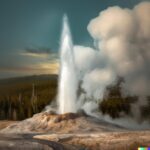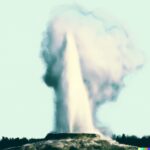Have you ever wondered how geysers work and what causes their spectacular eruptions? From the water supply to the heat source, several key factors come into play when it comes to geyser eruptions.
In this article, we will explore the various factors that influence geyser eruptions, how they interact to cause these natural wonders, and the different types of geysers that exist in the world. So sit back, relax, and get ready to dive into the fascinating world of geysers!
What is a Geyser?
A geyser is a natural phenomenon typically found in volcanic regions where underground water is heated by magma close to the Earth’s crust, resulting in periodic eruptions of hot water and steam.
This process begins with water seeping into cracks in the Earth’s surface, where it comes into contact with hot rocks and magma. As the water heats up, pressure builds up until it is released in a powerful eruption. The combination of heat from the Earth’s core and volcanic activity creates the ideal conditions for geysers to form. Water plays a crucial role in this process as it circulates underground, absorbing heat and minerals from the surrounding rocks. These unique features are a mesmerizing display of the Earth’s natural energy at work.
How Do Geysers Erupt?
Geysers erupt due to the build-up of pressure from underground reservoirs of heated water and steam, often triggered by interactions with magma and the release of accumulated pressure through conduit systems.
This pressure build-up occurs as water from rainfall seeps into the ground and is heated by geothermal activity, creating a reservoir of hot water and steam beneath the surface. When magma chambers situated deep underground heat this reservoir, the water boils, turns into steam, and expands rapidly. As the steam tries to escape, it forces its way through narrow passages, creating pressure within the geyser system. Eventually, the pressure reaches a critical point where the geyser explosively erupts, sending hot water and steam shooting into the air in a majestic display of nature’s power.
What Are the Factors That Influence Geyser Eruptions?
Several factors influence geyser eruptions, including underground pressure variations, temperature fluctuations, and the presence of rock fractures that facilitate the movement of water and steam.
These factors work together in a delicate balance, with pressure buildup playing a crucial role in propelling water and steam upwards. When the pressure beneath the surface exceeds a critical point, it triggers the eruption, sending a powerful jet of water and steam into the air. Temperature fluctuations impact the boiling point of water, influencing the frequency and intensity of eruptions. The presence of rock fractures acts as pathways for water to travel through, creating channels for the eruption to occur with varying degrees of force.
Water Supply
The availability of water from aquifers and hydrothermal systems plays a crucial role in geyser eruptions, as the interaction between liquid water and heat sources initiates boiling processes that drive geological activity.
This interaction creates a unique environment underground, where the heat from magma or other subsurface heat sources meets the water trapped in porous rock formations. As the water seeps into the Earth’s crust, it encounters these high-temperature conditions, causing it to heat up and expand rapidly. This build-up of pressure leads to the explosive release of steam and hot water through vents, creating the spectacular eruptions we witness at geysers.
Understanding the precise mechanisms behind this phenomenon sheds light on the dynamic processes shaping our planet’s geology.
Heat Source
The heat derived from magma and thermal energy sources is a primary factor influencing geyser eruptions, affecting the frequency of eruptions and contributing to ongoing geological activity.
This heat serves as the driving force behind the boiling and pressurization of water in underground reservoirs, creating the buildup of steam that eventually leads to explosive releases through geyser vents. Magma, with its intense heat, fuels the thermal energy required for water heating and expansion, while also contributing to the formation of underground chambers that play a crucial role in maintaining the hydrothermal system’s activity. Understanding the intricate relationship between these heat sources and geyser eruptions provides valuable insights into the dynamic nature of geothermal features.
Confining Pressure
Confining pressure, along with steam pressure dynamics, serves as a critical trigger mechanism for geyser eruptions, influencing eruptive patterns and responding to geothermal gradient variations.
The interaction between these factors is intricate, as the confining pressure acts as a restraining force that builds up within the geyser’s underground chamber until it overcomes the resistance, leading to a sudden release of pressure and the eruption of hot water and steam. The steam pressure within the geyser’s conduit further amplifies the explosive energy when it reaches a critical point.
Understanding these dynamics can provide valuable insights into predicting geyser behavior and studying the underlying geological processes that shape these remarkable natural phenomena.
Geothermal Gradient
The geothermal gradient, characterized by temperature variations in underground reservoirs, influences geyser eruptions by regulating energy release, responding to precipitation inputs, and shaping surface features.
As the temperature increases with depth in the Earth’s crust, it impacts the reservoir temperature of the geyser system, ultimately influencing the frequency and intensity of eruptions. The dynamics of energy release within the geyser are intricately linked to the geothermal gradient, with higher temperatures leading to more powerful bursts.
The geyser’s responses to variations in precipitation can be observed, as changes in water influx may trigger alterations in eruption patterns. The interaction between these factors also contributes to the formation of unique surface characteristics around the geyser site.
Rock Permeability
The permeability of rocks, influenced by fractures, minerals, and sediments, affects geyser eruptions by controlling the flow of water, steam, and pressure distribution over varying time intervals.
Fractures within rocks provide pathways for water and steam to move through the subsurface, affecting how quickly pressure builds up and consequently impacting the timing and intensity of geyser eruptions. The mineral composition of rocks can either enhance or inhibit this permeability, influencing the overall behavior of geysers.
Sediment deposition in rock formations can alter the flow pathways, leading to changes in water retention and eventual release during eruptions. Understanding these factors is crucial for predicting geyser activity and studying the dynamics of underground water systems.
Underground Channels
The presence of underground channels, linked to hydrothermal features, fault lines, and seismic activity, influences geyser eruptions and is vital in implementing effective monitoring techniques for predictive analysis.
These underground channels serve as pathways for geothermal fluids to travel through the Earth’s crust, playing a crucial role in the build-up of pressure that eventually leads to a geyser eruption. The interconnected network of channels not only allows for the movement of water and steam but also facilitates the transfer of heat and minerals.
By closely monitoring these channels and their connections to fault lines and seismic events, scientists can gain valuable insights into the behavior of geysers and the underlying geological processes. Advanced monitoring techniques such as seismic sensing and geodetic measurements are essential tools in understanding and predicting geyser activity with greater precision.
How Do These Factors Interact to Cause Geyser Eruptions?
The interaction of various factors like water supply, heat sources, pressure conditions, rock permeability, and underground channels collectively determines the occurrence and intensity of geyser eruptions.
These factors create a complex web of relationships that govern the behavior of geysers. Hydrological patterns play a crucial role in supplying the water necessary for eruptions, with geophysical data correlations helping to predict potential activity. Subsurface conditions, such as the presence of fractures and conduits, influence the pathway of ascending water and steam. Understanding geyser dynamics requires a holistic approach that considers not only individual elements but also their interconnectedness and the dynamic interplay between them.
The Role of Water Supply and Heat Source
Water supply and heat sources synergistically drive geyser eruptions through hydrological processes, mineral interactions, and steam generation, showcasing the intricate balance between fundamental elements.
The hydrological pathways within a geyser system play a crucial role in channeling water from the surface through cracks and fissures deep into the earth’s crust, where it comes into contact with intense heat sources. As this water interacts with minerals present in the underground reservoirs, it accumulates energy and pressure. The combination of these factors leads to the formation of steam that further builds up pressure within the geyser’s conduit, ultimately triggering the awe-inspiring eruption that characterizes these natural phenomena.
The Role of Confining Pressure and Geothermal Gradient
Confining pressure and geothermal gradients interact to modulate geyser eruptions by regulating energy release, managing pressure build-up, and influencing thermo-fluid dynamics within the system.
These factors work together to create a delicate balance that drives the spectacular eruptions observed at various geysers around the world. As the confining pressure changes, it affects the boiling point of water in the geyser reservoir, determining when an eruption may occur. Geothermal gradients play a crucial role in providing the heat necessary to facilitate the vigorous boiling and subsequent release of pressure that characterizes geyser eruptions. Understanding these intricate relationships is key to deciphering the mesmerizing behavior of these natural wonders.
The Role of Rock Permeability and Underground Channels
Rock permeability and underground channels play a pivotal role in geyser eruptions by controlling water movement, sediment deposition, surface features, and thermal anomalies that influence eruption patterns.
The interconnected network of underground channels affects the hydraulic conductivity within geyser systems, dictating the rate at which water can ascend towards the surface. This water flow mechanism is crucial in understanding the buildup of pressure underneath, which ultimately leads to the spectacular eruptions seen in geysers.
Sediment interactions within these channels also impact the overall eruption dynamics, influencing the frequency and magnitude of geothermal events. The formation of unique crater structures above the geyser vents is intricately linked to the way in which rock permeability influences the upward movement of water and steam.
These thermal irregularities in the subterranean environment contribute significantly to the variability observed in geyser eruption characteristics, making each geyser a fascinating natural wonder to study.
What Are the Different Types of Geysers?
Geysers exhibit diverse formations, including fountain geysers that eject water vertically, cone geysers with distinctive cone-shaped structures, erupting geysers with explosive releases, and steam vents emitting continuous steam emissions.
-
Fountain geysers, such as the famous Old Faithful in Yellowstone National Park, are characterized by their regular and impressive water spouts.
-
Cone geysers, on the other hand, like the Beehive Geyser, have tall cone-shaped mounds that build up over time with mineral deposits.
-
Erupting geysers, like the Steamboat Geyser, boast powerful eruptions that can shoot water and steam hundreds of feet into the air.
-
Steam vents, like those found in Iceland’s geothermal areas, create a mystical atmosphere with their constant release of steam without explosive eruptions.
Fountain Geysers
Fountain geysers are characterized by vertical water eruptions, mineral depositions, observable physics phenomena, surface observations, and satellite imagery that capture their dynamic behavior.
These geothermal features display remarkable water ejections that can reach impressive heights due to the natural pressure buildup below the earth’s surface. The mineral formations left behind by the continuous water flow create unique and diverse patterns, offering insights into the composition of the underground layers.
The physics principles governing the eruption of fountain geysers involve a delicate balance of pressure and temperature changes, resulting in the fascinating spectacle we witness. Surface characteristics, such as surrounding terrain and vegetation, play a crucial role in understanding the localized impact of these geysers on the ecosystem.
The use of satellite imagery allows scientists to remotely monitor and study the changes in activity, providing valuable data for geothermal research and environmental assessment.
Cone Geysers
Cone geysers exhibit cone-shaped structures due to sediment accumulation, chemical interactions, remote sensing applications, and geographic information systems that aid in mapping and analyzing their geological features.
These unique geological formations are a result of sediment gradually building up over time around the vent through which the geyser erupts, creating the distinctive cone shape. The chemical processes within the geyser play a significant role in the formation of these sediment formations, affecting their composition and color.
Remote sensing technologies such as LiDAR and satellite imagery enable researchers to study these cone geysers from a distance, capturing detailed data on their morphology and surroundings. Geographic Information Systems (GIS) tools are utilized to create digital models and maps that provide insights into the underlying geological properties and behavior of cone geysers.
Fountain-Cone Geysers
Fountain-cone geysers combine features of both fountain and cone types, showcasing diverse heat transfer mechanisms, precipitation effects, monitoring networks for data collection, and heat-related phenomena.
These transitional geysers stand out in the geothermal landscape for their unique blend of characteristics. The heat exchange processes within these geysers play a crucial role in their formation and activity, with both convection and conduction contributing to the energy transfer underground. The interaction of groundwater with the hot rocks beneath the surface creates the ideal conditions for these geysers to manifest their distinct behavior.
By understanding the intricate dance of heat involved in shaping fountain-cone geysers, researchers can gain valuable insights into the geological processes at play.
Erupting Geysers
Erupting geysers are known for explosive energy releases, distinct time intervals between eruptions, seismic monitoring with seismographs, and the involvement of liquid water in the eruption process.
These natural phenomena showcase remarkable energy discharge events, with some geysers releasing immense power during eruptions, propelling water and steam high into the air. The frequency cycles of eruptions vary from geyser to geyser, with some erupting regularly while others have more irregular patterns. Seismographs play a crucial role in detecting and recording the seismic activity associated with geyser eruptions, providing valuable insights into the geological processes beneath the surface. The interplay between liquid water and steam during eruption sequences creates dynamic and awe-inspiring displays of nature’s power.
Last Updated on February 11, 2024 by Jon Waraas – Originally Posted: February 11, 2024

I’m Jon Waraas, and I’ve been navigating the online world since 2006. By day, I’m the proud owner of some eCommerce gems, and by night, I’m the voice behind the adventures on Waraas.Com.
My heart, however, belongs to the wild beauty of Yellowstone National Park. I’ve got a collection of websites dedicated to sharing the wonders of this natural masterpiece. Oh, and did I mention? I’m currently building my own cabin inside the ghost town of Gilmore, Idaho – a cabin with tales to tell!
When I’m not immersed in the digital realm, you’ll find me lacing up my boots for a good hike or setting up camp under the star-studded sky.




